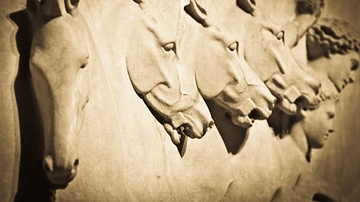Illustration
The Alexander Sarcophagus is a late 4th century BCE stone sarcophagus adorned with bas-relief carvings of Alexander the Great. The Alexander Sarcophagus is one of four massive carved sarcophagi, forming two pairs, that were discovered during the excavations conducted by Osman Hamdi Bey at the necropolis near Sidon, Lebanon in 1887 CE. The central figure may represent Hephaestion, one of Alexander's key commanders. (Istanbul Archaeology Museum)
About the Author
Cite This Work
APA Style
Raddato, C. (2014, May 20). Alexander Sarcophagus (detail). World History Encyclopedia. Retrieved from https://www.worldhistory.org/image/2664/alexander-sarcophagus-detail/
Chicago Style
Raddato, Carole. "Alexander Sarcophagus (detail)." World History Encyclopedia. Last modified May 20, 2014. https://www.worldhistory.org/image/2664/alexander-sarcophagus-detail/.
MLA Style
Raddato, Carole. "Alexander Sarcophagus (detail)." World History Encyclopedia. World History Encyclopedia, 20 May 2014. Web. 27 Mar 2025.









